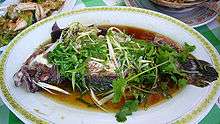Steaming



Steaming is a method of cooking using steam. This is often done with a food steamer, a kitchen appliance made specifically to cook food with steam, but food can also be steamed in a wok. In the American southwest, steam pits used for cooking have been found dating back about 5,000 years. Steaming is considered a healthy cooking technique that can be used for many kinds of food.
Method
Steaming works by boiling water continuously, causing it to vaporize into steam; the steam then carries heat to the nearby food, thus cooking the food. The food is kept separate from the boiling water but has direct contact with the steam, resulting in a moist texture to the food. This differs from double boiling, in which food is not directly exposed to steam, or pressure cooking, which uses a sealed vessel.
Such cooking is most often done by placing the food into a food steamer, typically a circular container made of metal or bamboo. The steamer usually has a lid that is placed on the top of the container during cooking to allow the steam to cook through the food. When a steamer is unavailable, food can be steamed inside a wok, supported over boiling water in the bottom of the wok by a stainless steel frame. Some modern home microwave ovens include a structure to cook food by steam vapor produced in a separate water container, providing a similar result to being cooked by fire. There are also specialized steam ovens available.
Steamed foods
Some of the earliest examples of steam cooking have been found in Cochise County, Arizona, where steam pits were used for cooking about 10,000 years ago.[1] In China's Yellow River Valley, early steam cookers made of stoneware have been found dating back as far as 5000 BCE.[2] From the eighth century CE, thin cypress strips were used to make steamers; today they are constructed from bamboo with slatted bases. The classic steamer has a chimney in the center, which distributes the steam among the tiers.
In Western cooking, steaming is most often used to cook vegetables—it is rarely used to cook meats. However, steamed clams are prepared by steaming. With Chinese cuisine, vegetables are usually stir fried or blanched and seldom steamed. Seafood and meat dishes are steamed. For example: steamed whole fish, steamed crab, steamed pork spare ribs, steamed ground pork or beef, steamed chicken and steamed goose. Rice can be steamed too, although in Chinese cooking this is simply referred to as "cooking" rather than "steaming". Wheat foods are steamed as well. Examples include buns and Chinese steamed cakes.
Steamed meat dishes (except fish and some dim sum) are less common in Chinese restaurants than in traditional home cooking, because meats usually require longer cooking times to steam than to stir fry. Commercially sold frozen foods (such as dim sum) formerly had instructions to reheat by steaming, until the rise in popularity of home microwave ovens, which have considerably shorter cooking times.
Benefits
Overcooking or burning food is easily avoided when steaming it. Individuals preferring to avoid additional fat intake may prefer steaming to methods which require cooking oil. Steaming also results in a more nutritious food than boiling, because fewer nutrients are leached away into the water, which is usually discarded.
A 2007 USDA comparison between steaming and boiling vegetables shows the most affected nutrients are folic acid and vitamin C. When compared to raw consumption, steaming reduces folic acid by 15%, and boiling reduces it by 35%. Steaming reduces vitamin C by 15%, and boiling reduces it by 25%.[3]
Steaming, compared to boiling, showed 42% higher amount of glucosinolates in broccoli cooked for medium firmness.[4] Phenolic compounds with antioxidant properties have been found to retain significantly better through steaming than through boiling or microwaving.[5] Steaming compared to boiling retained β-carotene in carrots.[6] The effect of cooking food may increase or decrease the nutrients.[3][7]
See also
- Food steamer
- List of steamed foods
- Mushiki, a East Asian steamer made from bamboo
- Double steaming
References
| Wikimedia Commons has media related to Steaming. |
- ↑ Rich Johnson (March 1999). Richard L. Jamison, ed. "Ancient Steam Pit Cooking". Primitive Outdoor Skills. Horizon Publishers: 33. ISBN 0-88290-666-6.
- ↑ Chen, Cheng-Yih (1995). Early Chinese Work in Natural Science. Hong Kong: Hong Kong University Press. p. 198. ISBN 962-209-385-X.
- 1 2 Nutrient Data Laboratory (December 2007). "USDA Table of Nutrient Retention Factors, Release 6" (PDF). USDA.
- ↑ Bongoni, R; Verkerk, R; Steenbekkers, B; Dekker, M; Stieger (September 2014). "Evaluation of Different Cooking Conditions on Broccoli (Brassica oleracea var. italica) to Improve the Nutritional Value and Consumer Acceptance.". Plant Foods for Human Nutrition. 69 (3): 228–234. doi:10.1007/s11130-014-0420-2.
- ↑ Vallejo, F; Tomás-Barberón, FA; García-Viguera, C (November 2003). "Phenolic compound contents in edible parts of broccoli inflorescences after domestic cooking". Journal of the Science of Food and Agriculture. 83 (14): 1511–1516. doi:10.1002/jsfa.1585.
- ↑ Bongoni, R; Stieger, M; Dekker, M; Steenbekkers, B; Verkerk, R (November 2014). "Sensory and health properties of steamed and boiled carrots (Daucus carota ssp. sativus)". International Journal of Food Sciences and Nutrition. 65 (7): 809–815. doi:10.3109/09637486.2014.931360.
- ↑ Sushma Subramanian (March 31, 2009). "Fact or Fiction: Raw veggies are healthier than cooked ones". Scientific American.
